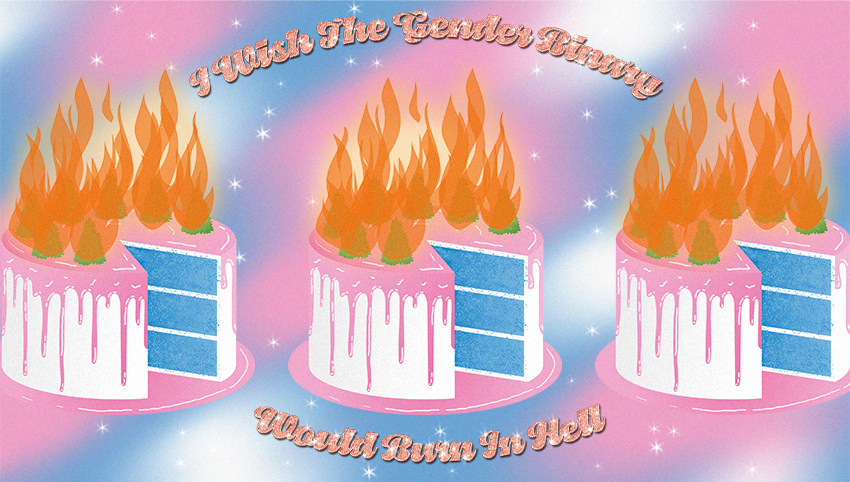The californian wildfires: AN APT METAPHOR FOR THE GENDER BINARY?
By Lauren McLoughlin / 6 October 2020

Illustration by Jade Pughe
Before I begin this article, I’d like to note that I am not attempting to trivialise or dismiss the devastation and damage that the ongoing Californian wildfires are wreaking across North America. Nor am I suggesting (as others have) that a single, poorly planned gender reveal party triggered what is currently 7,718 fires and over 3 million acres of ruined land. Record high temperatures, soaring humidity and considerable electric storms are responsible for the majority of fires across California, even if a few blue fireworks did alight the 10,000 acres that burned in El Dorado. Nonetheless, with the collective outrage of internet users ready to charge two parents-to-be for the raging fires, it seems only apt that parallels between the destructive Californian inferno and the gender binary be drawn.
In many ways, gender reveal parties are just another internet fad designed to satisfy our generation’s craving for social media attention and validation in the form of likes and emojis.
But the performative nature of these parties - the “big reveal” of cutting a cake with pink sponge inside, opening a box full of blue balloons, or (though I see this declining after recent events) setting pink fireworks up into the sky for all to film - speaks to the significance that our society places on this binary. Pink or blue? Girl or boy?
Without launching too deeply into Judith Butler’s theory on the performativity of gender, it is becoming increasingly clear that gender is not so much an inherent part of us as it is “a process by which patterns of action and language come to repeat themselves”. Butler suggests that the banality and omnipresence of these gender-identifying actions assure that we never question why we perform them, leading to the supposed “innateness” of gender. Take female fashion, for instance. As a child, I watched films and TV shows with princesses in and played with dolls and toys all wearing dresses. I saw my parents go out for dinner - my mum in a skirt and heels and my dad in a shirt and tie. I went to school in a summer dress or winter skirt whilst my male classmates wore trousers or shorts. I always wore a skirt or dress whenever there was a birthday, or special occasion, and was told, “wow, Lauren, you look so pretty”. As an adult, I will probably always wear a dress to feel more elegant, more feminine, more beautiful. But do I wear a dress because I’m a girl? Or am I a girl because I wear a dress?
If we divorce these actions from the biology that they supposedly represent, they seem almost ridiculous. It’s feasible that the reverse was equally as likely - “masculine” performances being “feminine” and vice versa. One need only look as far as the Bhutanese Gho, the Tibetan Chuba or the Scottish Kilt to question this rule.
Regardless of whether items of clothing are masculine or feminine, the purpose of this distinction remains unclear.
Has it ever really been necessary to identify one’s biology through clothing, or colour schemes, or haircuts? To signify clearly which members of the population are inseminated, and which inseminate? Even these two categories are becoming increasingly blurred as the evidence mounts that sex is far more complex, and far less distinct, than we once presumed. With this in mind, the gender binary appears not only inadequate, but incredibly harmful.
Most obviously, those people whose identities reside outside of or between the categories of male and female often suffer at the hands of this binary. In March 2020, it was deemed “lawful” that non-binary gender identification remain excluded from UK passports. A result that not only denies non-binary gender identity, but forces non-binary individuals to collude in its legal erasure by incorrectly declaring themselves male or female to obtain a passport. The psychological pain that this denial of identity perpetuates is becoming increasingly well documented as individuals and activists share their stories. That we’d rather invalidate the identities of 2.6 million UK citizens than put an ‘X’ on a passport attests to how deeply binary gender is entrenched in our society and psyches.
Similarly, the assigning of gender to babies born intersex - i.e. with reproductive or sexual anatomies that don’t adhere to medical definitions of male and female - is incredibly problematic.
Unlike 20 years ago, this decision is now rarely accompanied by painful and irreversible gender assignment surgery to ensure cosmetic conformity to “male” or “female” anatomy, but remains stringently enforced by social means. The Intersex Society of North America advises that “we give that child the label of “boy” or “girl” and thereby float them into the gender stream of our culture”.
Yet, studies indicate that as many as 60% of intersex children are incorrectly gendered, and are at greater risk of psychological harm, mental health issues and identity confusion as a result. In short, what most hope is a nonchalant float down the “gender stream” is in fact more akin to going over Niagara Falls in a barrel. Kimberly Zieselman, director of InterACT, has suggested that gendering is necessary to protect intersex children from “harmful discrimination and stigma” growing up, but how can we expect this to change if we continue to force children into a binary that their very existence invalidates? With the growing visibility of non-binary, gender nonconforming and transgender individuals, and small advancements like the first baby born without a gender on their health card, the decide-and-hope method of assigning gender to intersex children seems more redundant than ever.
So, as the Californian wildfires blaze through millions of acres of land, partly at the hands of a few parents all-too-eager to proclaim their child’s gender to the world, perhaps it’s time to evaluate the real purpose of this binary in 2020.
Honestly, I’m not sure there is one.
Art by
Words by
Share this article

